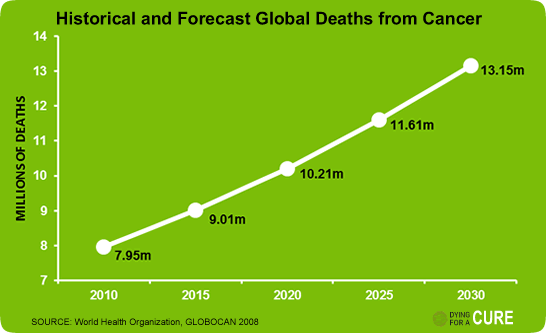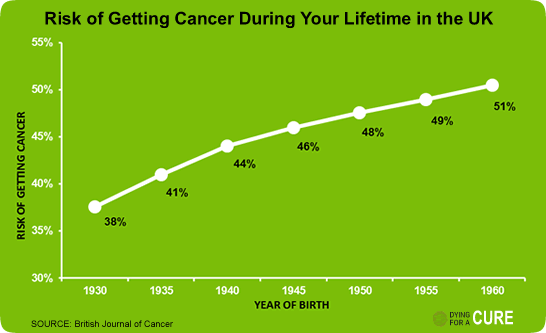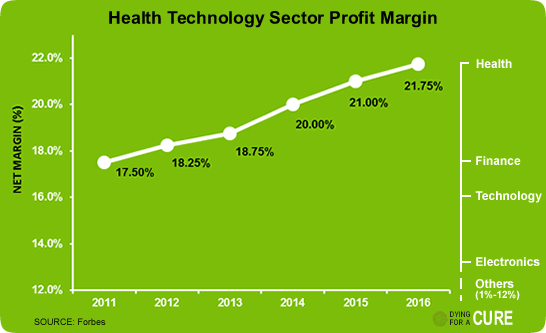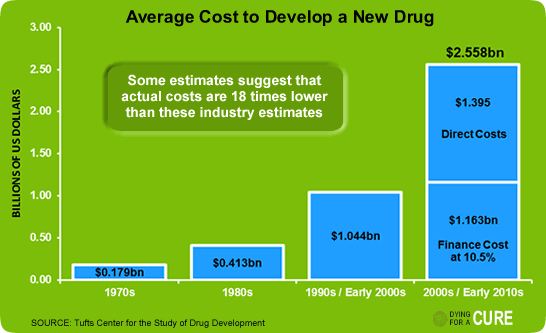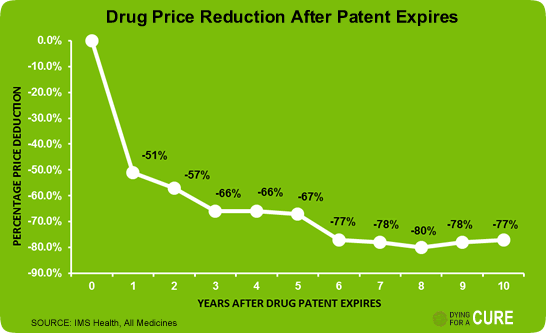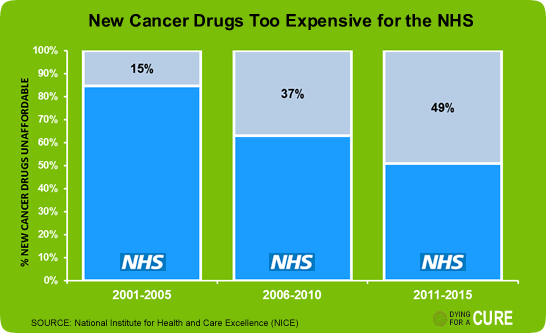Key Facts
This page brings together a number of key facts and figures to help shed light on the problems with the current approach to developing cancer drugs.
Cancer is a Large and Growing Problem for Society
This year over 9 million people will die of cancer worldwide – one every 3.5 secondsAccording to the World Health Organisation, the number of people who died of cancer worldwide in 2012 was 8.2 million. The figure is now estimated to be over 9 million and is forecast to rise to over 13m by 2030. Already this is one death from cancer every 3.5 seconds but but 2030 it could be one every 2.3 seconds.
Twice as many people die of cancer than HIV/AIDS, TB, Malaria and Hepatitis C combined
Cancer is also now one of the leading causes of death in the world. To put it into perspective, more than twice as many people die from cancer than from HIV/AIDS, malaria, tuberculosis and hepatitis C combined.
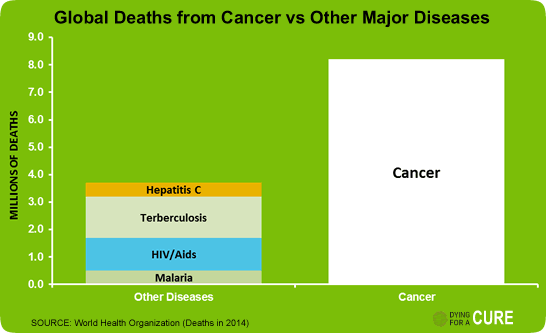
Half of us are now expected to get cancer at some point in our lives
The risk of getting cancer during our lifetime is also growing, with cancer incidence rates now at an all time high.
Cancer is also a Large and Growing Market for Businesses
Globally we spend over $107bn (£75bn) on buying cancer drugsAs we rely primarily on private companies to develop and produce cancer drugs, the growing prevalence of cancer creates a growing market opportunity for these companies. Global sales of cancer drugs were $107bn in 2015 and are forecast to rise to between $148bn and $178bn by 2020.
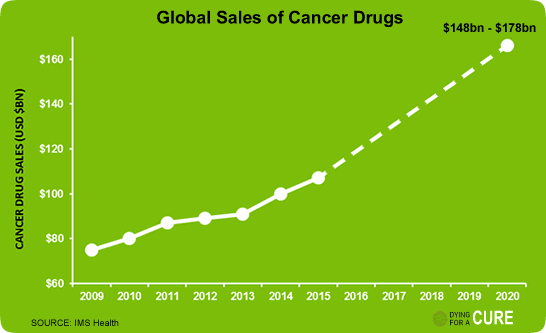
In 2015 we spent $44bn (£30bn) worldwide on just 10 cancer drugs
About 40% of the revenues generated from sales of cancer drug come from just 10 drugs, which together generated over $44bn of sales in 2015. These drugs have generated combined revenues of over $300bn since they were approved, an average of $30bn per drug.
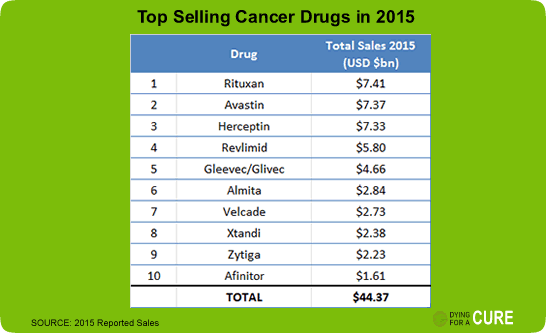
Cancer drug companies are making average profit margins of over 20%
Weak regulation and competition in the pharmaceutical market has led to exceptional profit margins. The following table shows the profit margins in 2015 of the top seven pharmaceutical companies with the largest shares of the global cancer drug market. The consequence for patients of high profit margins is higher prices for cancer drugs. Higher drugs prices lead to drugs being priced out of reach of patients in countries that can’t afford them (including the UK), resulting in many patients dying sooner.

The pharmaceutical industry is the most profitable industry in the world
Profit margins in the pharmaceutical industry are the highest of any major industry in the world and have been steadily rising for some time.
Very Few New Cancer Drugs Are Approved Each Year
On average, less than 10 new cancer drugs are approved each yearThe high costs and risks associated with developing cancer drugs results in only a small number of new drugs being developed and approved each year, despite that fact that there are almost 200 types of cancer. On average over the last 10 years, the Food and Drug Administration approved an average of 9.5 new cancer drug treatments per year. Some of these approvals are for the same drug but for use with a different cancer, so the actual number of drugs being developed is less than this.
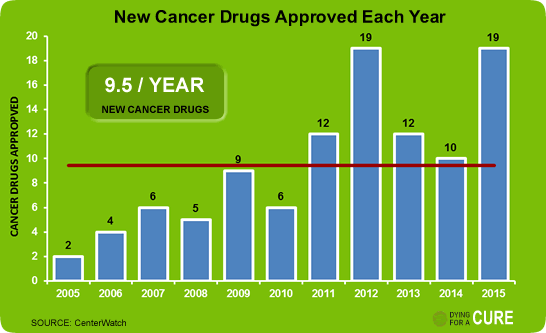
In the last 5 years, between 2011 and 2015, new drugs were developed for only 10% of the 200 different types cancers.
New Cancer Drugs only offer Marginal Benefit
New cancer drugs only extend lives by 2.7 months more on averageAs well as only a small number of new cancer drugs being developed each year, those that are developed only have marginal benefits for patients, partly due to a lack of incentives to deliver significant innovation.
A study published in The JAMA Network in 2014, found that new cancer drugs that have been developed over a 12 year period from 2002 to 2014 were only marginally better than existing ones. The study looked at all the new cancer drugs for solid tumours approved by the Food and Drug Administration between January 2002 and April 2014. It found that on average, where the impact on patient survival was known, new drugs were only expected to extend patients’ lives by an additional 2.1 months compared with existing treatments. Some drugs had been approved on the basis of Progression-Free Survival (a second-best measure that doesn’t always translate into improved survival) and even these drugs had an estimated survival benefit of only 2.5 months. Combining Overall Survival and Progression-Free Survival data to use the best available data for each drug gives an average survival benefit of 2.7 months.
New Drug Development is Costly and Inefficient
New drugs cost $2.6bn (£1.8bn) to develop – 40% of this is a finance cost at a rate of 10.5%It is very expensive to develop a new drug, partly due to the lengthy timescales and costs involved in testing the drug to confirm its safety and effectiveness (typically 10 years from synthesis to approval), partly due to the fact that 88% of drugs investigated don’t end up getting approved and partly due to the use of expensive money to finance the investment at a rate of 10.5% (the average cost of capital for the pharmaceutical industry).
There is also a huge amount of duplication worldwide, which further adds to the overall cost to society of developing cancer drugs. A 2014 study into the lack of innovation in new cancer drugs found that 74% of new drugs being developed by 9 of the top 10 drug companies were very similar to drugs being developed by their competitors.
Over the years, the cost of developing a new drug has risen steeply and is now estimated to be $2.558bn (£1.75bn). However, many people believe that this figure is exaggerated. An independent report published in 2011 by the London School of Economics and Political Science concluded that actual drug development costs were 18 times lower than the industry estimates presented here, which it claims were influenced by commercial sponsorship from pharmaceutical companies, as R&D costs are used by the pharmaceutical companies to help defend high prices for drugs.
Drug Firms are Charging Huge Monopoly Premiums
Prices for new drugs fall by 78% when drug patents expire allowing competitors to produce themThe current drug patent system gives drug companies legal monopolies over the supply of new drugs for 20 years, regardless of how beneficial they are. A period of this time is taken up developing the drug, so the average effective monopoly period is around 12 years. During this monopoly period the drug companies can charge a premium over and above the price that we would normally pay in an open competitive market. This monopoly premium is then used to pay for the costs of developing the drug. Once drug patents expire, prices typically fall by around 78%.
R&D costs for the top 10 drugs have already been paid back 9 times over
Given that drug prices fall by about 78% in an open market, as competitors are then able to manufacture and supply the product, we can estimate the monopoly premium charged by the pharmaceutical companies to cover R&D costs. For many cancer drugs, this monopoly premium is enough to pay back R&D costs many times over. The top 10 cancer drugs have already generated enough revenue to pay back their R&D costs 9.4 times over, even using the highest estimate of R&D costs. Given that a number of these drugs have many years of exclusivity left under their patents, this figure will increase over the coming years unless prices are significantly reduced to open market levels.
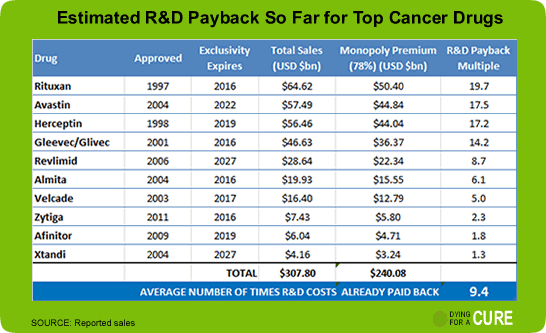
Cancer Drugs Have Become Increasingly Unaffordable
Only half of new cancer drugs are deemed cost-effective for the NHS, down from 85% in 2001-2005The lack of competition and regulation has enabled drug companies to set whatever prices they like for new drugs. Prices vary enormously by country and to protect downward pressure on prices, drug companies are often willing to forgo access to smaller markets like the UK rather than reduce prices to levels that we can afford.
At present the Government either pays the high price demanded by the drug companies, or it refuses to pay, leaving patients to be treated with older, less effective medicines that offer reduced life-expectancy. Some groups have called for NHS price caps to be raised but there are concerns that this will simply fuel further price escalation.
Survival Rate Improvements Overstate Progress in Beating Cancer
Comparisons of survival rates over time may be extremely misleadingProgress in beating cancer is usually measured using survival rates – typically 5 or 10 year survival from diagnosis. However, a large study of cancer survival rates over a 45 year period found that they may be extremely misleading, as changes in 5-year survival rate over time bore little relationship to changes in cancer mortality. Unfortunately cancer survival rates don’t prove that patients are living longer, only that they are living with cancer for longer, as they can be inflated by earlier diagnosis, which may not always lead to delayed death.
A more reliable measure of progress in beating cancer is cancer mortality rates, i.e. what proportion of the population dies of cancer. The good news is that cancer mortaility rates have been declining, but relatively slowly and much slower than the improvements seen with other diseases.
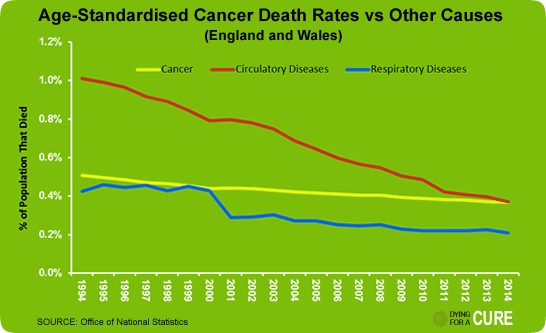
The risk of dying from cancer is rising as progress lacks that of other diseases
The poor progress with cancer relative to other diseases means that the likelihood of dying from cancer has unfortunately been rising over the last decade.
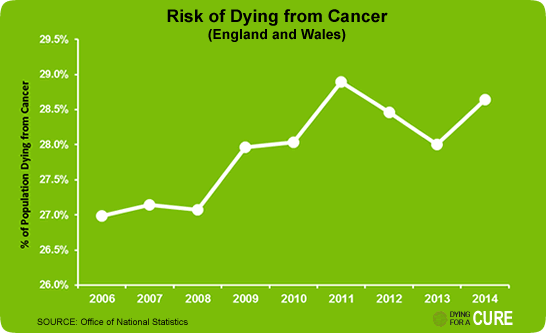
In fact, the risk of dying from cancer is higher now for almost all ages than it was in 2006.

Funding New Cancer Drugs in the Public Sector Would Be Much Cheaper
Funding new cancer drugs in the private sector is hugely wasteful and expensiveThe following diagram shows how cancer drugs are currently funded. Given the above facts about the number of cancer drugs developed each year, how much each new drug costs to develop and how much prices fall when patent monopolies expire, and assuming that 90% of the money spent on cancer drugs is spent on drugs under patent protection, we can estimate that around $75bn (£57bn) of the total we spend on cancer drugs each year goes towards R&D for new cancer drugs. As R&D costs are estimated to be only around a third of this figure at most, this helps explain the huge profit margins being made.
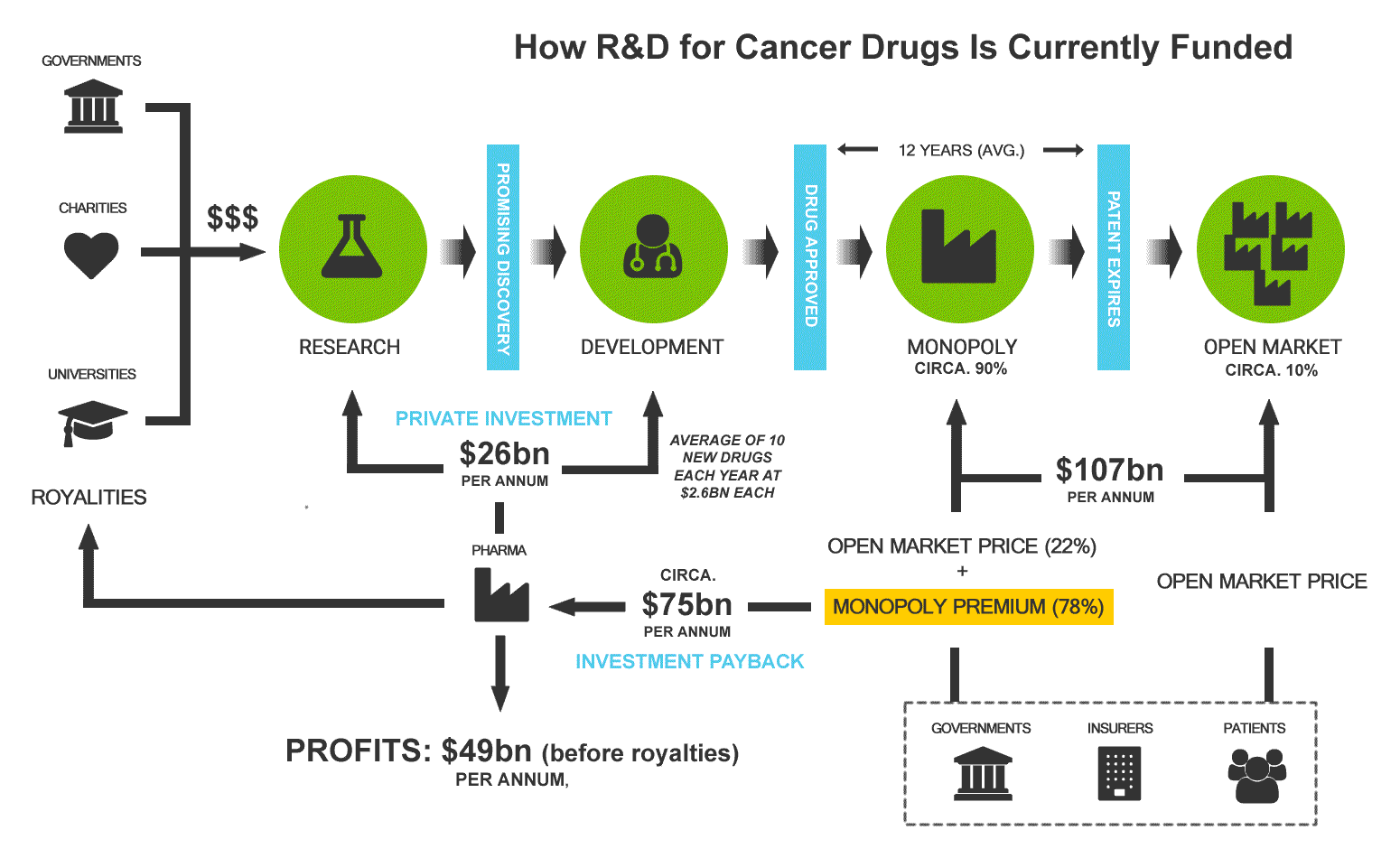
Funding new cancer drugs in the public sector could radically reduce costs
Funding the development of new cancer drugs in the public sector would enable costs to be radically reduced, by using much cheaper Government borrowing and by eliminating the wasteful duplication that currently exists where competing drug companies invest in very similar new drugs.
Furthermore, the choice of which new drugs to develop could be made solely based on potential benefits to patients rather than potential commercial benefit, which could significantly improve the pace of innovation.
It would also enable new drugs to be sold at significantly lower prices, based on manufacturing costs alone, as drug patents could be retained in the public domain allowing non-exclusive licenses to be issued to competing manufacturers. This would significantly improve access to new drugs.
Overall this approach has the potential to radically transform the way we tackle cancer, with more effective treatments available to far more people, for a much lower overall cost to society.
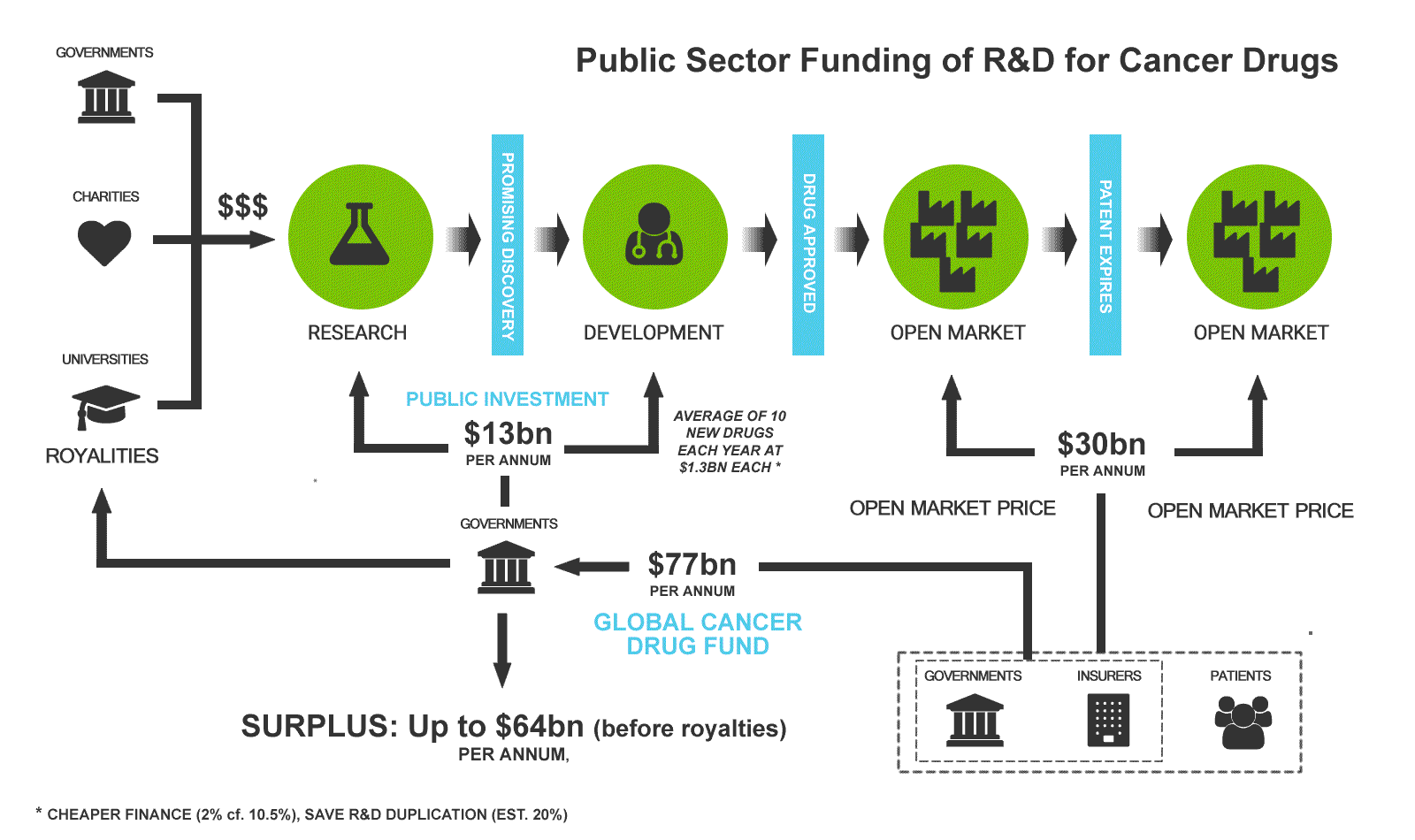
Shocking Facts
These are shocking facts and clear evidence that cancer is being treated as a massive money-making opportunity instead of the growing humanitarian crisis it is.
Please help us encourage the UK Government to implement market reforms to address this by signing our petition.


